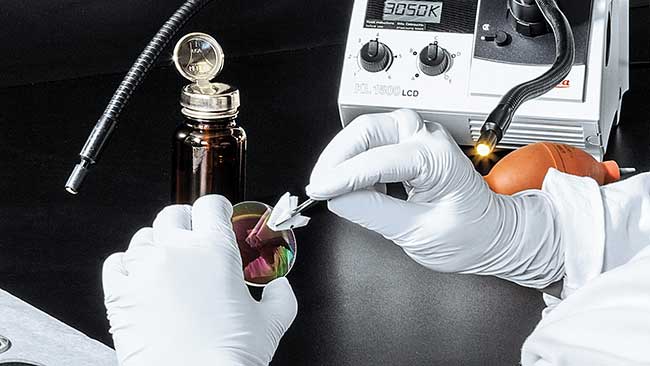
Cleaning Your Laser Optics Can Bolster Efficiency and Safety
HUYEN VU, LASER COMPONENTS
Laser optics, in use or in storage, always acquire a level of contamination from water, skin oils, dust and other substances. Contamination of this key component of a laser system can distort beam alignment and drift away a focused spot from the original setup. It also can negate the safety margins that were designed into the optics, resulting in optical damage under conditions where they would not normally occur.
This is especially true for high-power laser systems, where contaminated elements heat up. This causes distortion as the optics change shape and refractive index and eventually ends up destroying the system.

Cloth soaked in isopropanol cleans dielectric coated glass. Courtesy of Laser Components.
The potential for damage doesn’t stop there. In industrial applications, contaminated optical elements very often cause more contamination and debris to spread with negative effects on the quality, output and lifetime of a laser system. In R&D, contaminated optical elements lead to false data, in the best case. In the worst case, they can destroy entire multimillion-dollar laser setups. In medical applications, the effects of having wrong focal spots or misaligned laser beams in a laser system can be fatal to patients.
Improving and perfecting the cleaning process of premium optics is an ongoing concern. No matter how precisely developed your laser optics may be, contamination can always cause problems.
Taking into account optical substrate material and using corresponding cleaning procedures will contribute to the overall efficiency of your laser system, keep it safe and avoid downtime or reduction of laser output power. In case of doubt about how to handle your laser optics, we always recommend contacting the manufacturer.
Cleaning procedures
Laser optics are delicate and need to be handled with great care. Small scratches caused by using tweezers during the cleaning process, for example, can have tremendous impact on the laser-induced damage threshold of the optics. So only clean optics when they are visibly dirty.
Wear latex gloves and work over a clean, dust- and clutter-free surface. It is a good idea to clean the optics mount, too. If the optics are dirty, chances are that the mount is dirty as well.
Different optics require different handling. Basically, there are three types of laser optics relevant to the cleaning process: dielectric coated glass (usually fused silica or BK7), zinc selenide optics, and metal and metal-coated optics.
Dielectric coatings on fused substrates are usually hard and durable. Always start cleaning optics made with these coatings with a gas duster or a rubber blower bulb to clean off the surface. Also, blow-clean sides, chamfers and the back of the optic where dust/debris could accumulate. Never use your breath. This will leave tiny droplets of saliva on the surface.
Then completely remove all excess dirt, oil and grease by washing the optics using warm water with very mild liquid detergent or acetone.
The next step is to wipe the lens with an acetone- and isopropanol-resistant cloth or tissue. Fold the tissue to create a plane surface for cleaning.
Use a tweezer or hemostat to hold the cloth as parallel as possible to the fold. Soak the cloth with acetone or isopropanol. The substrate can best be cleaned by starting in the center and then slowly rotating the cloth out to the edge. Repeat until you don’t see any contamination. Don’t forget to give the edge an extra wipe at the end.
Zinc selenide is relatively soft compared with other optical materials. Consequently, greater care should be made while cleaning. The first step is the same as before: Remove dust with a gas duster or rubber blower. Then, use a Q-tip to remove contamination. Wet the cotton tip with acetone or alcohol and wipe the surface gently. Repeat, using fresh Q-tips, until all contamination is gone.
Metal and metal-coated optics require different procedures depending on the materials. Bare metal optics (usually copper) can be cleaned using liquid metal polishers, but you should only clean them when they are very dirty. After that step, wash the optic with acetone.
The coating of gold-coated mirrors is extremely soft, and we do not recommend cleaning these optics at all. They can easily be damaged by minor contacts with abrasive material. Replacement is usually the way to go.
If cleaning is absolutely necessary, avoid contact with the surface of the mirror. Flush the optics with acetone and follow that by applying dry nitrogen, making sure to wear latex gloves and hold the optics only on the sides. But keep in mind that chances are very high that cleaning might damage the optics.
Meet the author
Huyen Vu is the sales director of laser optics, diodes and modules at Laser Components USA and has been in the laser industry since 2000; email: [email protected].
/Buyers_Guide/Laser_Components_USA_Inc/c8005
Published: September 2017
OpticsLaserslensesindustrialLaser ComponentsHuyen VuPICKS: Expert Advice on Optimizing Performance